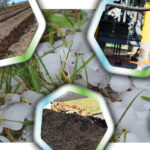 ‘
‘
Nora Goldstein
BioCycle December 2014
As 2014 draws to a close, it is a good time to reflect on where we’ve been and where we’re headed. It has been an interesting year in the organics recycling universe, with highs such as the commercial organics ban going into effect in Massachusetts and California Governor Jerry Brown signing into law two pieces of legislation that will significantly increase organics diversion — and lows such as some electric utilities not renewing power purchase agreements at “survivable” rates for digesters, and the closure of one of the largest source separated organics composting facilities on the East Coast in the state of Delaware.
But all in all, BioCycle’s estimates show that the quantity of organics diverted to composting and anaerobic digestion (AD) facilities in the U.S. has increased in 2014. More dots have been added to the organics recycling facilities map than removed, indicating positive momentum and strength in numbers. And the outputs of these facilities — compost, mulch, electricity, renewable natural gas and heat — have paying markets, although perhaps not as widespread and high paying as operators desire.
And that last sentence brings us to where we are headed in 2015. But first some background. I have had the opportunity to attend conferences outside of the organics recycling arena in 2014. These have included the Food Marketing Institute’s and Grocery Manufacturers Association’s Global Sustainability Summit in Boston, the EcoDistricts Summit in Washington, D.C., and the International Society of Sustainability Professional’s annual conference in Denver. At these events, I listened to keynote presentations by business strategists including Andrew S. Winston, author of The Big Pivot: Radically Practical Strategies for a Hotter, Scarcer and More Open World, Joel Makower, chairman and executive editor of GreenBiz Group Inc., and lead author of the annual State of Green Business report, and L. Hunter Lovins, president and founder of Natural Capitalism Solutions and author of The Way Out: Kick-Starting Capitalism To Save Our Economic Ass. Each of these keynotes emphasized the need for innovative, sustainability-focused technologies and services that must simultaneously grow the economy and manage the fallout from a changing climate.
Which brings us back to current markets for the outputs of composting and AD facilities. Each keynoter discussed threats to our national security from the impacts of climate change, including food and water security. They also noted the critical need to shift away from fossil fuels, responsible for a huge chunk of the CO2 emissions causing global warming. And what do the valuable products of organics recycling have to offer? Compost for soil fertility, moisture retention, water infiltration and carbon sequestration. Biogas for renewable energy and fuels. Digestate for nutrients and soil fertility. Healthy soils grow food. Biogas compressed into renewable natural gas fuels cars and trucks. Storm water infiltration recharges groundwater. Etcetera.
Demand for the outputs of organics recycling facilities will lead to more organics being diverted to these operations in order to produce these outputs. Demand also means higher prices. Higher prices for the outputs takes pressure off facilities to rely primarily on tipping fees for income. Etcetera.
The bottom line is strength in our numbers. Happy Holidays, and best wishes for the New Year!









